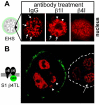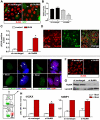Interconnected contribution of tissue morphogenesis and the nuclear protein NuMA to the DNA damage response
- PMID: 22331358
- PMCID: PMC3283872
- DOI: 10.1242/jcs.089177
Interconnected contribution of tissue morphogenesis and the nuclear protein NuMA to the DNA damage response
Abstract
Epithelial tissue morphogenesis is accompanied by the formation of a polarity axis--a feature of tissue architecture that is initiated by the binding of integrins to the basement membrane. Polarity plays a crucial role in tissue homeostasis, preserving differentiation, cell survival and resistance to chemotherapeutic drugs among others. An important aspect in the maintenance of tissue homeostasis is genome integrity. As normal tissues frequently experience DNA double-strand breaks (DSBs), we asked how tissue architecture might participate in the DNA damage response. Using 3D culture models that mimic mammary glandular morphogenesis and tumor formation, we show that DSB repair activity is higher in basally polarized tissues, regardless of the malignant status of cells, and is controlled by hemidesmosomal integrin signaling. In the absence of glandular morphogenesis, in 2D flat monolayer cultures, basal polarity does not affect DNA repair activity but enhances H2AX phosphorylation, an early chromatin response to DNA damage. The nuclear mitotic apparatus protein 1 (NuMA), which controls breast glandular morphogenesis by acting on the organization of chromatin, displays a polarity-dependent pattern and redistributes in the cell nucleus of basally polarized cells upon the induction of DSBs. This is shown using high-content analysis of nuclear morphometric descriptors. Furthermore, silencing NuMA impairs H2AX phosphorylation--thus, tissue polarity and NuMA cooperate to maintain genome integrity.
Figures






Similar articles
-
The control of tissue architecture over nuclear organization is crucial for epithelial cell fate.J Cell Sci. 2007 May 1;120(Pt 9):1596-606. doi: 10.1242/jcs.03439. Epub 2007 Apr 3. J Cell Sci. 2007. PMID: 17405811
-
NuMA promotes homologous recombination repair by regulating the accumulation of the ISWI ATPase SNF2h at DNA breaks.Nucleic Acids Res. 2014 Jun;42(10):6365-79. doi: 10.1093/nar/gku296. Epub 2014 Apr 20. Nucleic Acids Res. 2014. PMID: 24753406 Free PMC article.
-
NuMA influences higher order chromatin organization in human mammary epithelium.Mol Biol Cell. 2007 Feb;18(2):348-61. doi: 10.1091/mbc.e06-06-0551. Epub 2006 Nov 15. Mol Biol Cell. 2007. PMID: 17108325 Free PMC article.
-
Role of NuMA in vertebrate cells: review of an intriguing multifunctional protein.Front Biosci. 2006 Jan 1;11:1137-46. doi: 10.2741/1868. Front Biosci. 2006. PMID: 16146802 Review.
-
Mechanism of elimination of phosphorylated histone H2AX from chromatin after repair of DNA double-strand breaks.Mutat Res. 2010 Mar 1;685(1-2):54-60. doi: 10.1016/j.mrfmmm.2009.08.001. Epub 2009 Aug 12. Mutat Res. 2010. PMID: 19682466 Review.
Cited by
-
Architecture in 3D cell culture: An essential feature for in vitro toxicology.Toxicol In Vitro. 2017 Dec;45(Pt 3):287-295. doi: 10.1016/j.tiv.2017.03.012. Epub 2017 Mar 30. Toxicol In Vitro. 2017. PMID: 28366709 Free PMC article. Review.
-
Three-dimensional tracking using a single-spot rotating point spread function created by a multiring spiral phase plate.J Biomed Opt. 2022 Dec;27(12):126501. doi: 10.1117/1.JBO.27.12.126501. Epub 2022 Dec 29. J Biomed Opt. 2022. PMID: 36590978 Free PMC article.
-
Building risk-on-a-chip models to improve breast cancer risk assessment and prevention.Integr Biol (Camb). 2013 Sep;5(9):1110-8. doi: 10.1039/c3ib40053k. Integr Biol (Camb). 2013. PMID: 23681255 Free PMC article. Review.
-
Silver nanoparticles selectively treat triple-negative breast cancer cells without affecting non-malignant breast epithelial cells in vitro and in vivo.FASEB Bioadv. 2019 Sep 30;1(10):639-660. doi: 10.1096/fba.2019-00021. eCollection 2019 Oct. FASEB Bioadv. 2019. PMID: 32123812 Free PMC article.
-
Characterization and implementation of a miniature X-ray system for live cell microscopy.Mutat Res. 2022 Jan-Jun;824:111772. doi: 10.1016/j.mrfmmm.2021.111772. Epub 2021 Dec 9. Mutat Res. 2022. PMID: 34923215 Free PMC article.
References
-
- Ayoub N., Jeyasekharan A. D., Bernal J. A., Venkitaraman A. R. (2008). HP1-beta mobilization promotes chromatin changes that initiate the DNA damage response. Nature 453, 682-686 - PubMed
-
- Barcellos-Hoff M. H. (1998). The potential influence of radiation-induced micro-environments in neoplastic progression. J. Mammary Gland Biol. Neoplasia 3, 165-175 - PubMed
Publication types
MeSH terms
Substances
Grants and funding
- R01CA112017/CA/NCI NIH HHS/United States
- R01 CA112017/CA/NCI NIH HHS/United States
- U54CA143836/CA/NCI NIH HHS/United States
- U54 CA126552/CA/NCI NIH HHS/United States
- R37CA064786/CA/NCI NIH HHS/United States
- U54 CA112970/CA/NCI NIH HHS/United States
- R01 CA057621/CA/NCI NIH HHS/United States
- R01CA057621/CA/NCI NIH HHS/United States
- U01 CA143233/CA/NCI NIH HHS/United States
- R37 CA064786/CA/NCI NIH HHS/United States
- P41EB001046/EB/NIBIB NIH HHS/United States
- U54CA126552/CA/NCI NIH HHS/United States
- U54CA112970/CA/NCI NIH HHS/United States
- P41 EB001046/EB/NIBIB NIH HHS/United States
- U54 CA143836/CA/NCI NIH HHS/United States
- U01CA143233/CA/NCI NIH HHS/United States
- ImNIH/Intramural NIH HHS/United States
LinkOut - more resources
Full Text Sources
Other Literature Sources
Molecular Biology Databases
Research Materials
Miscellaneous

